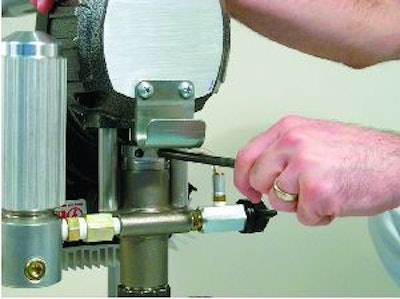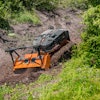
No matter how simple a piece of striping equipment may appear or how easy it may be to operate, it is going to require maintenance. And before a contractor begins a new season, it is important to make sure that equipment is maintained and functioning properly. While most manufacturers suggest doing maintenance at the beginning of the off-season, here are some parts/areas of striping equipment that should be double-checked before beginning your spring season.
Spray guns
If a spray gun starts spitting or clogs on the job a contractor's time will be wasted unnecessarily. It is much better to prevent these problems and save on unexpected costs before beginning striping. "You can tell when the parts are worn," says Steve Muellenbach, vice president and general manager of M-B Companies. "You can't really say 'Okay that gun should be rebuilt every 10,000 gallons' because that's not the case. You can see a disfigurement in the line. When the line does not look sharp and crisp something is wearing."
Mark Malloy, director of marketing for Airlessco, says guns, if not properly cleaned and stored during the off-season, can accumulate corrosion. Before starting up for a new season, Malloy says to remove the trigger guard, unscrew the filter and visually inspect the gun head and filter housing for any paint residue that needs to be removed. Residue left in the head can suddenly break loose causing the gun to spit or clog, he says. Also, filters inside the gun need to be cleaned or replaced. Malloy adds that a contractor should routinely check the spray gun for maintenance issues during the season as well.
Muellenbach says contractors also need to check the packings in the gun. The packings keep the paint from leaking through the needle assembly. One way to tell if a packing needs replacement is checking if the gun shuts off correctly. If it doesn't, that is a sign of a faulty or worn packing, Muellenbach says.
Hoses
High pressure paint hoses are a part that Malloy says most people don't pay attention to. And that is a big mistake. If a hose is damaged to the point that it starts to leak, a large amount of paint can leak out, he says. That not only costs the contractor money, but if a hose leaks on a job it will also cost the contractor time and possibly the client. Malloy points out that there is no in-the-field fix for a worn hose and to do so puts employees at risk of an injection injury. So it is important to check your hoses before the start of the season.
Todd Jepsen, contracting and refurbishment manager for EZ Liner/Vogel Traffic Services, says hoses should be checked for damage from rubbing. Rubbing causes wear on the hose. So a contractor needs to check the hose for any visible signs of wear.
It is also important to make sure hoses are not loose. No matter what kind of striping equipment a contractor owns, there will be vibrations in the system either from transportation or striping. These vibrations can cause the fittings on the end of a hose to come loose, Muellenbach says. It is important to check the fittings daily and tighten any that are loose.
Valves/balls
Striping equipment consists of many types of valves, all of which should be checked. Failure to check and maintain valves results in an inefficient system, problems dispensing paint, and unexpected downtime and costs, Jepsen says. A dip water test can be used on check valves and ball valves. This test allows the contractor to see if the valves have any leaks. "It's cheaper and easier to discover a problem with water than it is when the system is full of paint," he says.
It is also important to make sure pop off valves are working correctly. "We pull ours off, and we'll hook them in line to a system that is overrated for what that pop off valve is to make sure that it pops at its recommended rate," Jepsen says. "If it's 100 psi I want to make sure that it functions at 100 not at 130."
Like spray guns, balls in the pump are also susceptible to corrosion, Malloy says. Contractors should make sure these balls are seating and unseating properly before they start striping. Stuck balls will prevent the pump from priming. If the balls are corroded or some debris between the ball and seat is preventing them from sealing fully, the pump won't prime. This results in the pump either having to work harder or not working at all.
Filters
Like valves, there are different filters in a piece of striping equipment. And all of these filters should be cleaned or replaced before the start of the season. Malloy says contractors should make sure to check the engine air filter, filters in the gun, the high capacity filter (if the equipment has one), and the inlet filter at the end of the pickup tube. The inlet filter, or "rock catcher," catches relatively large objects such as lumps of paint. If it is not cleaned and maintained some of those lumps may get through and clog the tip.
Paint strainers should also be checked and replaced if necessary. "When you have to start increasing pressure in the system, there's a restriction some place. And more than likely it's going to be in the paint filter," Muellenbach says. When this happens a contractor should remove the paint filter and wash it out.
Tips
Spray tips are an important part of any striping equipment. As paint goes through the tip, it wears out the oval-shaped orifice to a round-shaped one, Malloy says. As a result, the spray pattern begins to round. When a tip is worn out it should be replaced. Jepsen says a contractor can tell when his tip is worn by looking at the way the line is spraying. Not only will the pattern be different, but more paint will be sprayed in the middle of the pattern because the hole in the tip is now round. Monitoring the spray pattern and periodically replacing worn spray tips can save a contractor money, Malloy adds.
Pumps
Many of the previously mentioned parts and maintenance tasks affect the functionality of a striper's pump. But the pump itself also needs attention. Jepsen says to make sure the pump is flushed out before beginning a new season. If the striper has a high-pressure pump, a contractor needs to make sure the piston is working correctly. If the piston is the same color as the paint a contractor uses, it is an indication that the pump needs to be rebuilt before using the striper again, he says. Muellenbach adds that contractors should replace the packings as necessary. Contractors can look for traces of paint in the piston cup to indicate a worn packing, Mullenbach says.
If your striping equipment has a transfer pump, it is important to check Teflon diaphragms for fatigue lines. A discoloration in the Teflon indicates a fatigue line and a pump that needs replacing, Muellenbach says.
Oil/engine
"This is the right time for the annual maintenance on your gasoline engine. It's the right time to check the air filter; it's the right time to change its oil simply because you're not likely to get to it again," Malloy says. "Oil changes are the absolute cheapest insurance for any gasoline powered engine. And the more you do it the longer the machine is going to live." Also make sure the gas tank, which should have been drained at the end of last season, is filled with fresh gas, Malloy adds.
Electrical system
Muellenbach says the electrical system is the heart of every unit. As humans, we know how important it is to keep the heart of a system healthy and running properly. Check the electrical system for drained batteries and improper alternator voltage. The timer, or microprocessor, is the heart of the electrical system, Muellenbach says. The drive line sensor of the timer should be cleaned or replaced. Check the hand boxes to make sure connections are tight, there is no corrosion, and the boxes are dry.
Also check the solenoids. These are critical for the start and stop of the gun. "If a solenoid is dirty, faulty, or has a weak coil you'll notice a tail in the end of the line. That's an indication that there's something wrong; there's an air restriction that's not allowing that gun to shut off crisp and clean," Muellenbach says. Solenoids can be checked indoors with a static run to make sure they are working correctly, he adds.
Hydraulics
Maintenance of the hydraulics is a little different than the other parts mentioned above. The type of maintenance that needs to be done and to what extent is situational based on a contractor's previous season, Jepsen says. History of problems from last season should indicate areas/parts that need to be checked and possibly replaced. "Depending on the number of hours the equipment was used the previous year I would recommend changing the hydraulic oil and changing any inline filter that might be on the system," Jepsen says.
Paint system/paint
Like all other parts of a striper, a contractor needs to make sure that his paint system is thoroughly cleaned, Muellenbach says. The paint tank needs to be drained and cleaned of any clumps. He also says to disassemble and clean the plumbing to get rid of any restrictions there. Agitators, which are often overlooked, should be cleaned, lubricated, and oiled, he adds.
One final consideration for contractors should be their paint. This is especially important if a contractor's off-season lasts more than a couple months. "Paint will separate out over a period of time," Jepsen says. "So if you're unsure of how your equipment is going to spray right off the bat, I would definitely recommend some kind of an agitation process." Ideally, a contractor should use fresh paint at the start of each season, but if that isn't possible making sure paint that has been sitting is re-agitated or stirred is vital.
Contractors should not wait until the last minute to make sure all parts of their striping equipment are maintained and working properly. "The determining factor of how soon to start preparation for start-of-season maintenance depends on the size of equipment contractors are using," says EZ Liner's National Sales and Marketing Manager Rob Krommendyk.
According to Krommendyk and Jepsen, for larger striping trucks contractors should usually set aside six to seven weeks for maintenance. For smaller equipment like walk-behind stripers, contractors should allow approximately two to three weeks for these issues, they say. However, availability of parts is another factor to consider when planning time for maintenance. "You don't want to be waiting for parts," Muellenbach says. "Time is everything."
An easy and organized way to prepare a striper for the spring season is to check parts and complete maintenance system by system, Muellenbach suggests. "And make sure that anything that needs to be checked, changed, lubricated, or replaced is done," he says.
"The biggest thing with preseason is to identify problems upfront so they don't become failures and result in breakdowns. And then document what you do so you know what to do from year to year," Krommendyk says.
A saying Jepsen hears often during the off-season is, "A corner that is cut now is going to be a curb that we hit later." Making sure all parts of your striping equipment are clean and functioning properly before your spring startup is the best way to ensure your equipment and season stay free of any unexpected curbs.




















